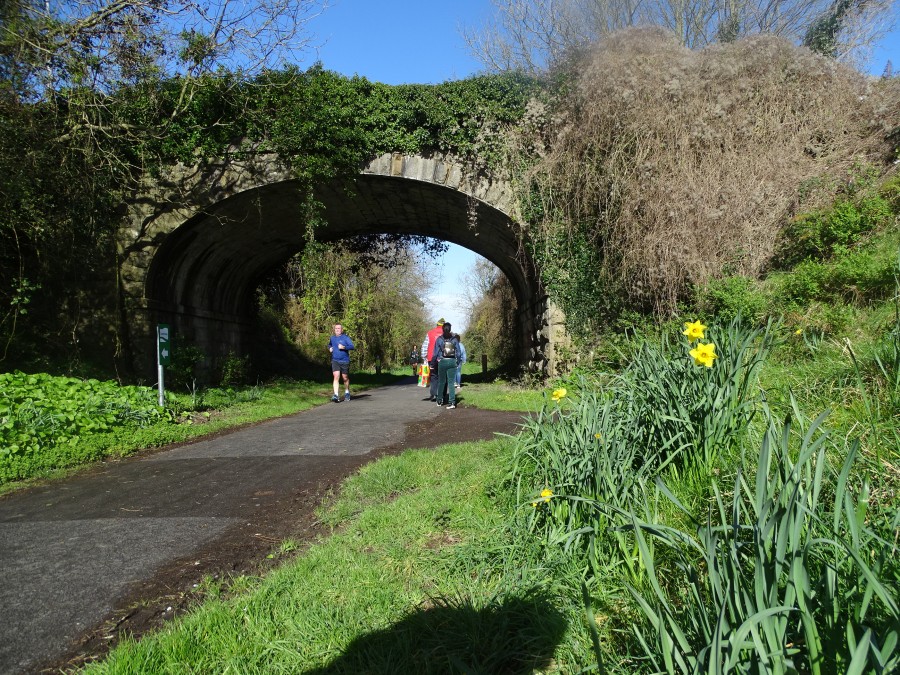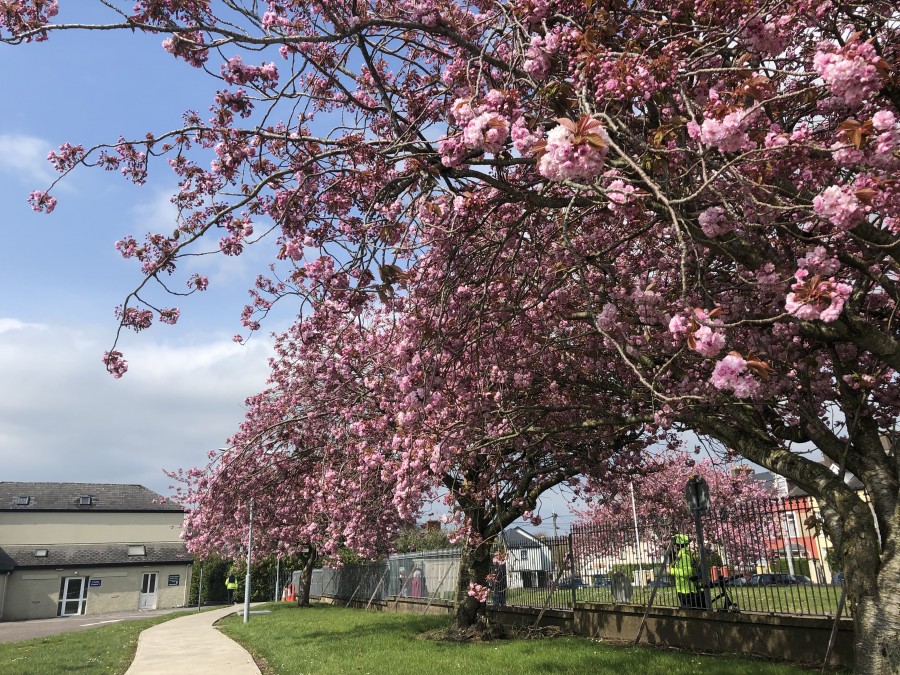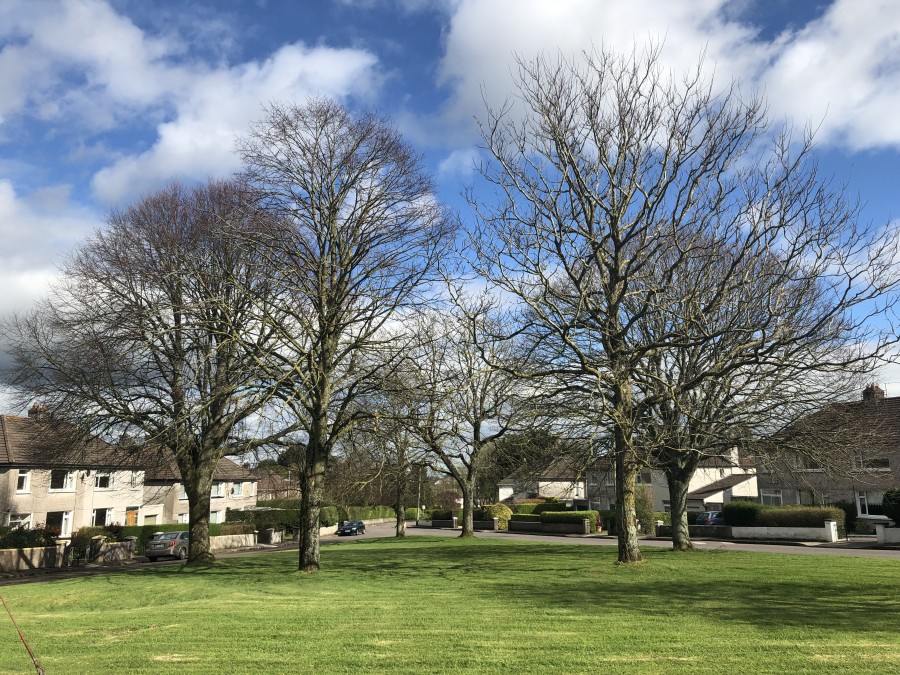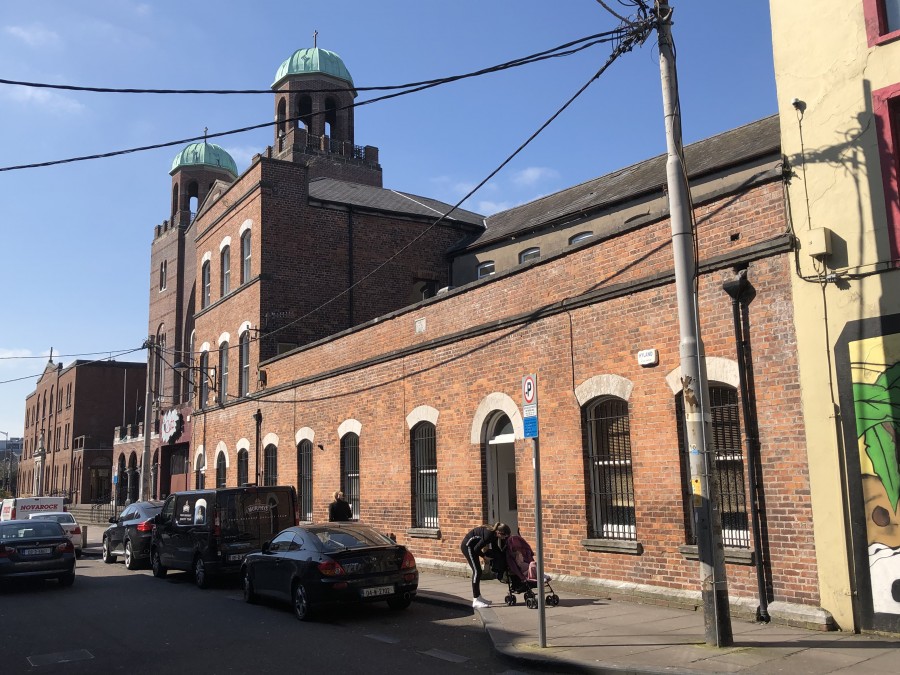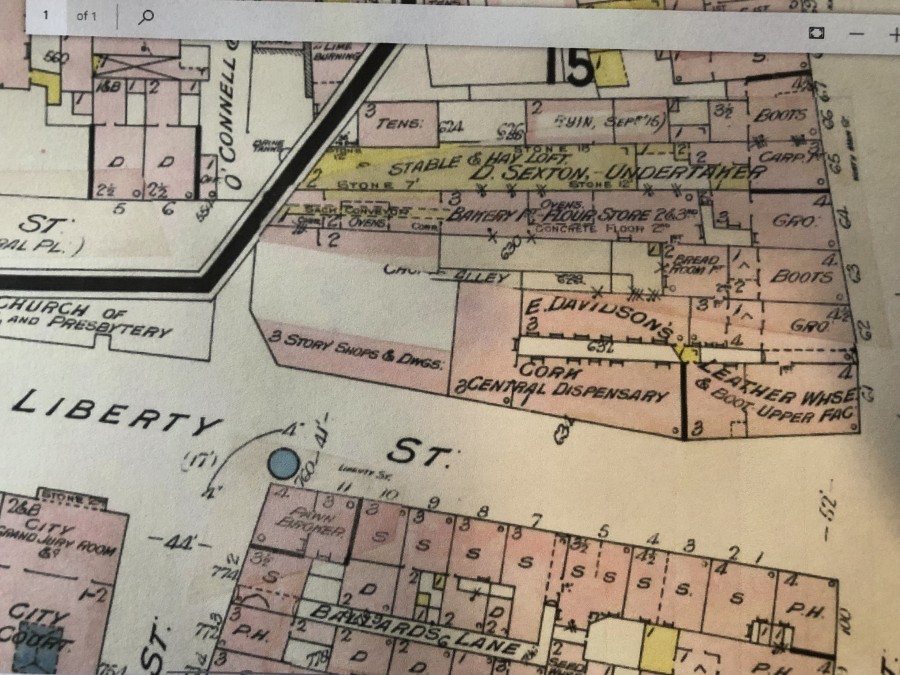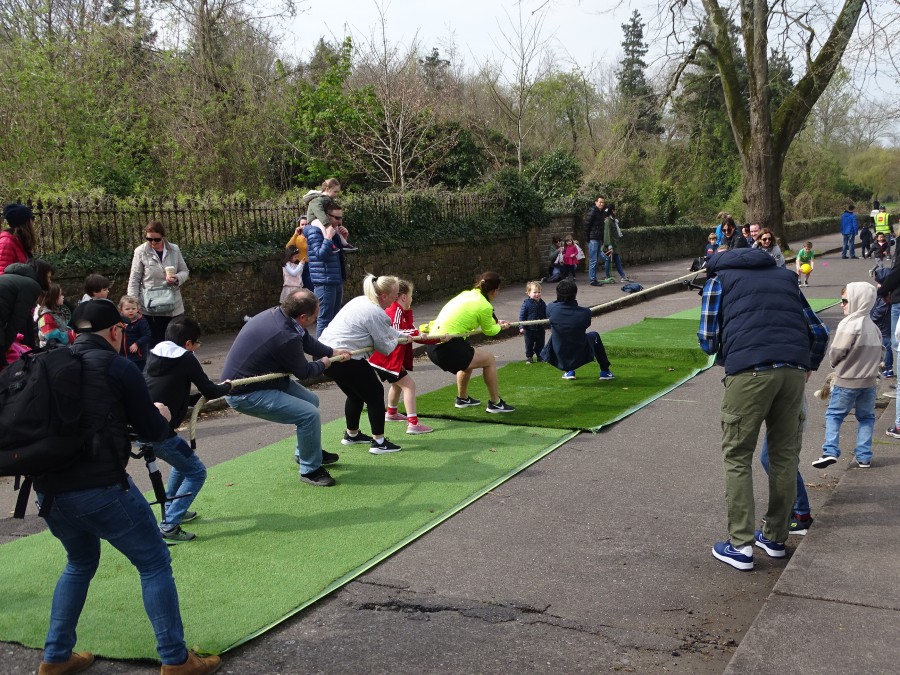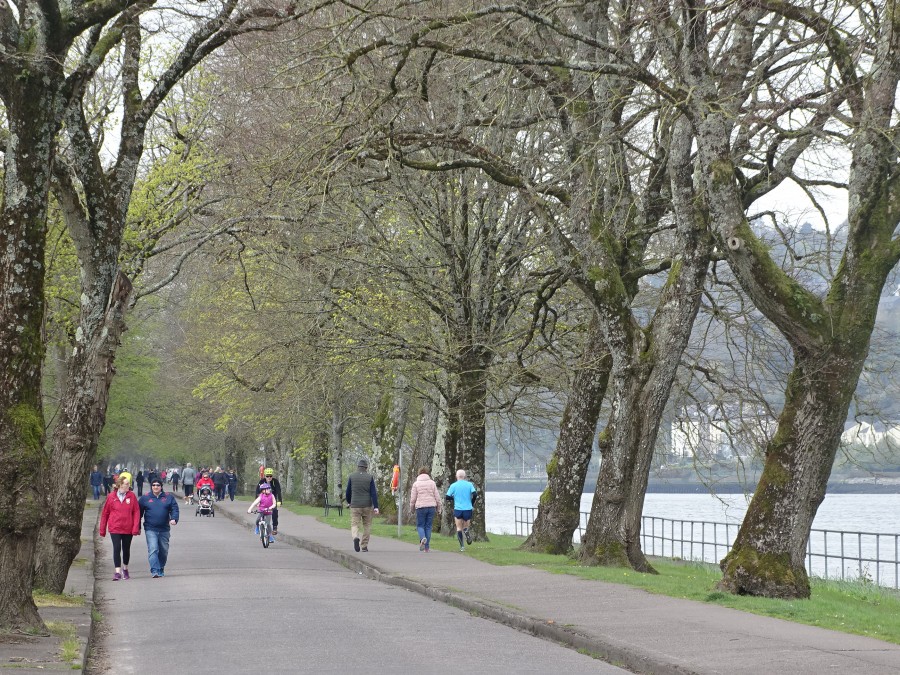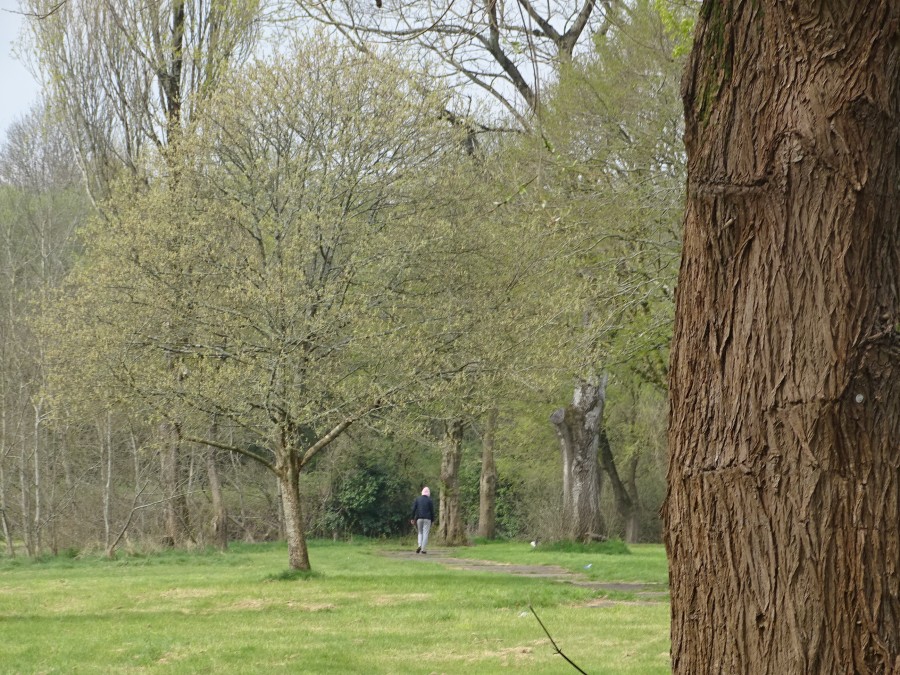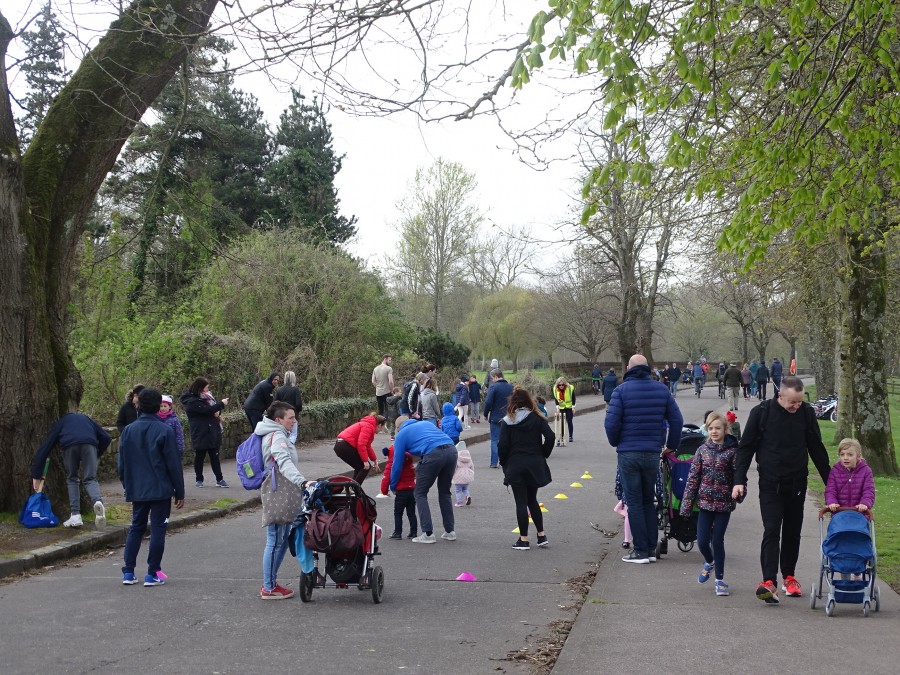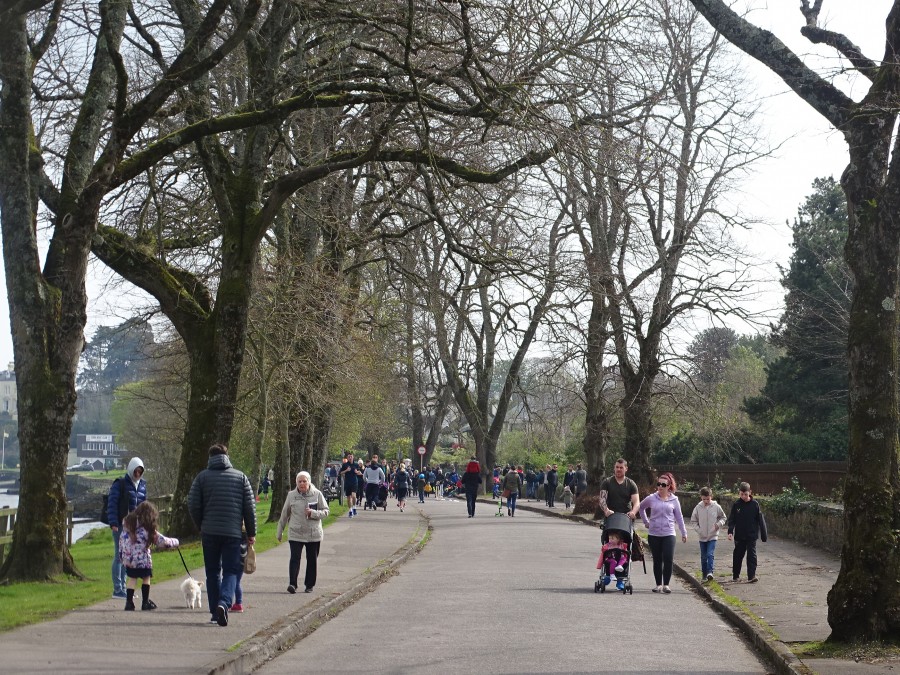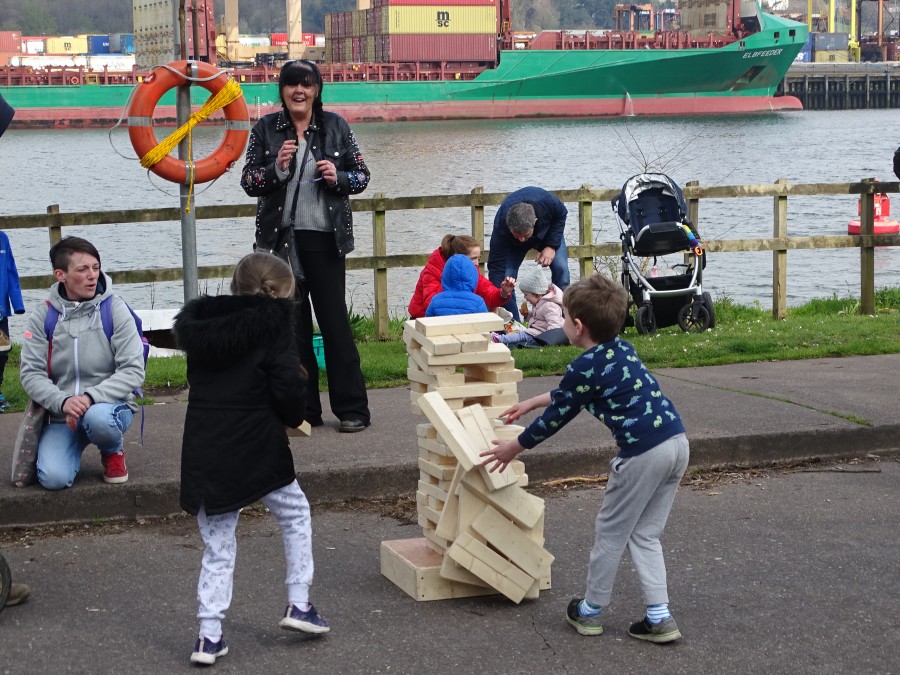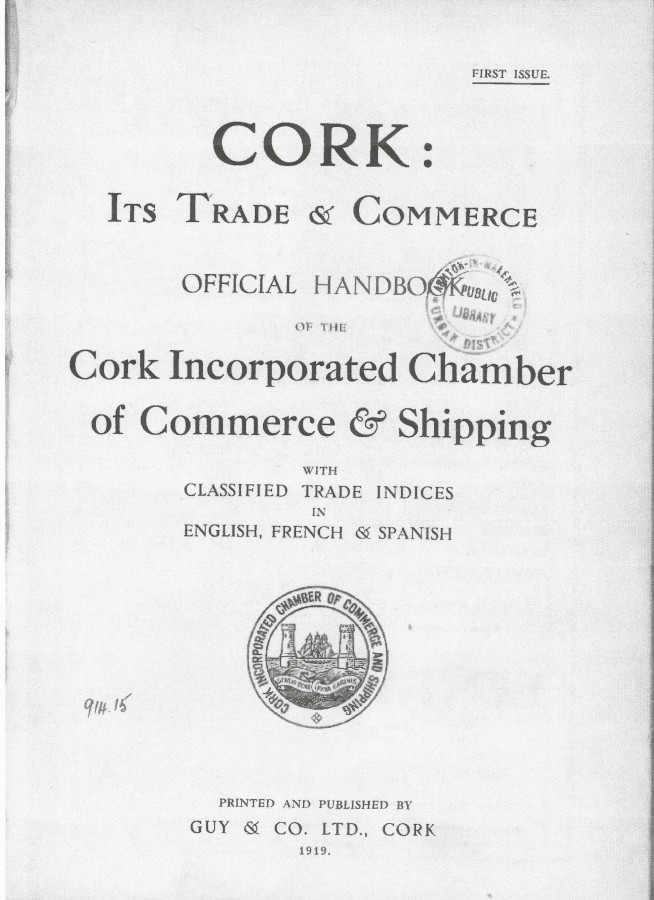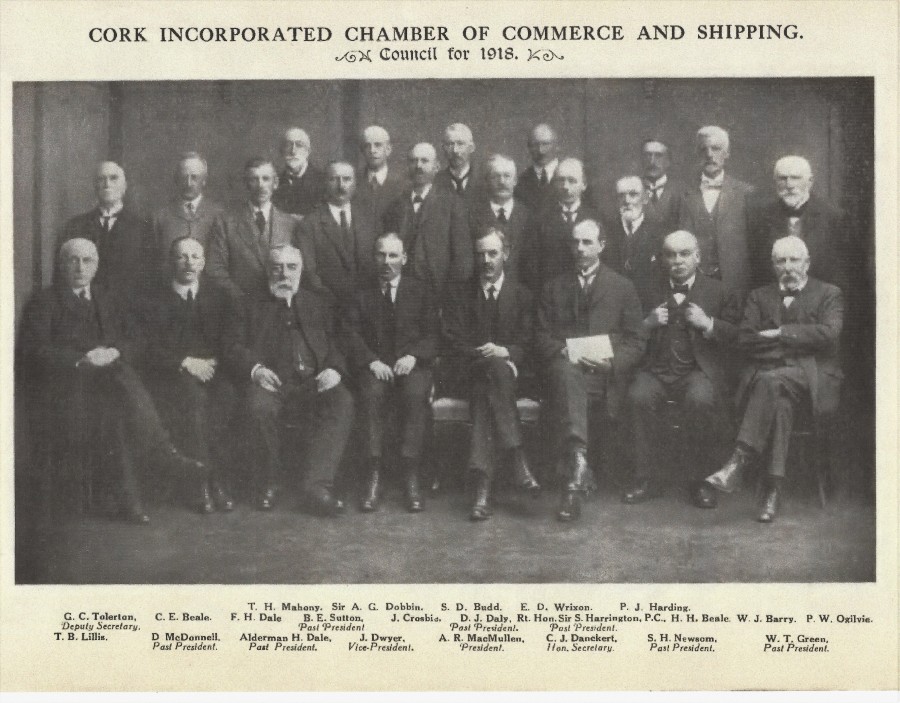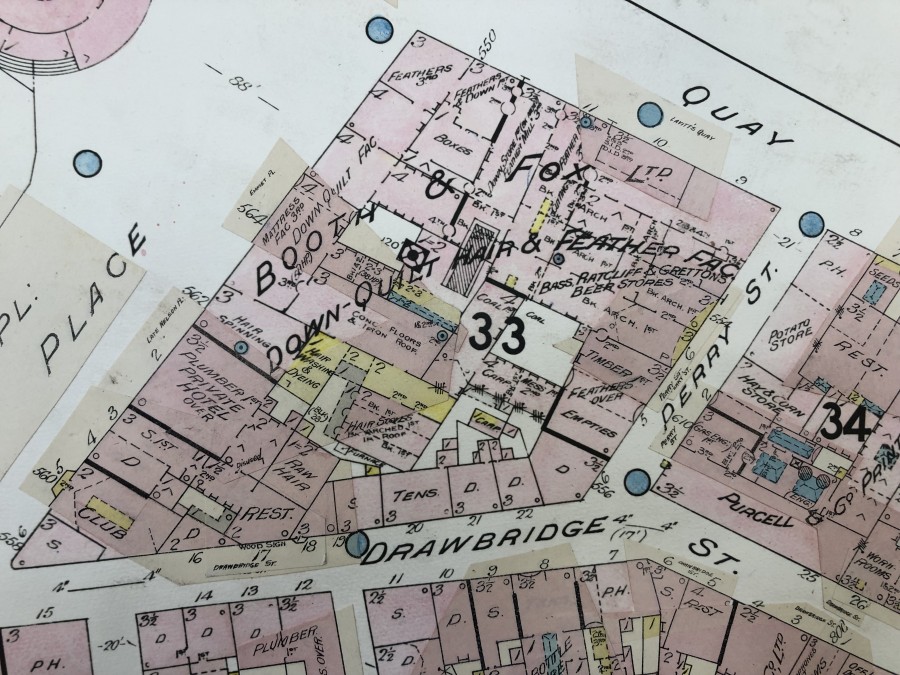Spring Landscapes, South East Ward, Cork, April 2019
Kieran’s Our City, Our Town, 11 April 2019
Kieran’s Our City, Our Town Article,
Cork Independent, 11 April 2019
Tales from 1919: Tuberculosis and the City Dispensary
One hundred years ago this week on 14 April 1919 a conference of representatives of the medical profession in Cork, the Public Health Committee of the Corporation, and the City Insurance Committee, was held to consider a scheme of how the Tuberculosis Act could be advanced further in Cork. The Tuberculosis Act was passed in 1908 but was not overtly followed through on primarily due to inadequate treatment facilities and a general lack of obligation by the public to declare infection if contracted.
Nationally since 1904, there had been a reduction of tuberculosis mortality amounting to about 25 per cent and noticeably found amongst persons between 25 and 35 years old. In Dublin the death rate in 1917 from tuberculosis was 23.3 per cent under that of 1907. In his report on the health of Cork City in 1917 Dr Denis O’Donovan, Medical Officer of Health noted high rates of contraction of tuberculosis; “the city of Cork possesses the unenviable notoriety of having the highest consumptive death rate of any town in Great Britain and Ireland. There were 202 or about 1/7 of the total number of deaths registered during the year, showing a slight diminution when compared to the previous year”.
In late March 1919, the scheme of the National Health Insurance Commission set out that the Corporation of Cork should be asked to commit themselves only to such expenditure as would enable a beginning to be made, to roll out a tentative scheme. There was no suggestion made that the Corporation were responsible and should incur any capital expenditure to the erection of a new dispensary or to the purchase of beds in institutions. An argument was presented that the existing premises on Liberty Street should be revamped and adapted for tuberculosis treatment and that beds in local hospitals should be secured at a certain sum per week, as and when required.
At the Cork conference of April 1919 Mr John Horgan presided with Doctors Crosbie, Rahilly and O’Donovan. The proposals made at the meeting and published in the minutes of the meeting in the Cork Examiner include calls for: (1) the appointment of a tuberculosis officer; (2) the establishment of a central dispensary; (3) the appointment of a whole-time nurse in connection with the dispensary, and the appointment of a part time nurse to assist her in visiting domiciliary patients; (4) beds in a sanitorium; (5) facilities for hospital treatment of surgical cases of tuberculosis; (6) the treatment as far as possible of advanced cases of tuberculosis and (7) the payment of fees to doctors in connection with the treatment in their own homes of those patients who would be unable to attend at a dispensary. The net cost of the scheme with such latter elements after deducting the contribution of the Insurance Committee, would be £1,547 13s 4d of which one half £773 16s 3d would be paid by the Treasury, leaving £773 16s 3d to be borne the rates of the city.
The secretary of the Conference Mr M O’Keeffe read a briefing received from the honorary secretary, Philip G Lee of the Cork medical profession. The unanimous feeling of the profession was that the proposed scheme was useless, as regards the prevention, detection and treatment of tuberculosis. They deemed that it was drawn up without technical knowledge of methods likely to be of service to check how tuberculosis was spreading in the district and what combination of local factors was leading to a relevant high deaths rate. The medical profession outlined that elements needed to be taken more into account such as overcrowding, insufficient ventilation within dwellings, insufficient scientific inspection of the dairies, cattle and milk supply outside the borough. The disease was spread amongst children through the ingestion of infected milk and non-medical inspection of schools. Compulsory notification and isolation of advance cases were needed. In 1916, it was estimated that there were 1960 cases of phthisis or tuberculosis in the city but only 15 cases were notified.
Central to any treatment of disease was the City Dispensary on Liberty Street. Built in 1878 it replaced a dispensary on Hanover Street. Minutes of the Cork Corporation’s Improvement Department for 8 March 1878 reveal that it aided in the widening of Liberty Street as the Deeble’s Mills were demolished and new buildings put further back as a result. The running of the Dispensary was overseen by the Corporation’s Dispensary Committee in association with the City’s Board of Guardians. Its early years was plagued by reports that such was the use of the services that conditions within the building were unsatisfactory and unsanitary.
Fast forward to 27 February 1917 and the Superintendent Medical Officer of Health Dr Denis O’Donovan reported he visited the dispensary on 25 February and found 45 persons, including men, women and children, standing in the hallway, outside the two rooms occupied by the doctors of numbers six and seven dispensary districts – the most populous ones in the city. The hallway was narrow, badly lighted, and not well ventilated, and there was a water closet situated at the far end in what was deemed a “most unsuitable position”. There was only seating accommodation provided in the hallway for ten persons, and if a case of infectious disease was found there in its early stages – a danger existed of it spreading rapidly. The poor conditions within the dispensary building was regularly critiqued in the Cork media. The building itself was sold in 1946 for new uses.
Kieran is also showcasing some of the older column series on the River Lee on his heritage facebook page at the moment, Cork Our City, Our Town.
Upcoming Tours:
Sunday 14 April, Stories from Cork Docklands, historical walking tour with Kieran, learn about the evolution of Cork’s Docklands from its early days through its historical maps, 19th & 20th century industrialisation to housing and community building; meet at Kennedy Park, Victoria Road 2.30pm (free, duration, two hours, area tour, part of the Cork Lifelong Learning Festival, finishes nearby).
Sunday 21 April 2019, Ballinlough Historical Walking Tour with Kieran, learn about nineteenth century market gardens, schools, industries, and Cork’s suburban standing stone, meet outside Beaumont BNS, Beaumont 2.30pm (free, duration: two hours, finishes on Ballinlough Road).
Captions:
992a. Arched windows of the former Cork City Central Dispensary on Liberty Street, present day (picture: Kieran McCarthy)
992b. Map of Liberty Street with Cork City Central Dispensary, 1915 from Goad’s Insurance Map (source: Cork City Library)
Cllr McCarthy presents Docklands and Ballinlough historical walking tours for April
Cllr Kieran McCarthy presents two more historical walking tours during the month of April.
Sunday 14 April, Stories from Cork Docklands, historical walking tour with Kieran, learn about the evolution of Cork’s Docklands from its early days through its historical maps, 19th & 20th century industrialisation to housing and community building, meet at Kennedy Park, Victoria Road 2.30pm (free, duration, two hours, area tour, part of the Cork Lifelong Learning Festival, finishes nearby).
Sunday 21 April 2019, Ballinlough Historical Walking Tour with Kieran, learn about nineteenth century market gardens, schools, industries, and Cork’s suburban standing stone, meet outside Beaumont Schools, Beaumont 2.30pm (free, duration: two hours, finishes on Ballinlough Road).
Cllr. McCarthy noted: “Ballinlough and Docklands are full of historical gems; the walks not only talk about these areas as important corners in the city’s development but also their identity and place within the historical evolution of our city. It is also a forum for people to talk about their own knowledge of local history in the area”.
Cllr McCarthy continued; “Ballinlough has a rich variety of heritage sites. With 360 acres, it is the second largest of the seven townlands forming the Mahon Peninsula. It has a deep history dating back to Bronze Age Ireland. It is probably the only urban area in the country to still have a standing stone still standing in it for over 5,000 years. Kieran’s walk will highlight this heritage along with tales of landlords, big houses, rural life in nineteenth century Ballinlough and the rise of its twentieth century settlement history. More on Kieran’s historical walking tours can be viewed on Kieran’s website, www.kieranmccarthy.ie.
Kieran’s Question to CE, Cork City Council Meeting, 9 April 2019
Question to the CE:
To ask the CE about progress on negotiations to retrieve the green in front of the Ursuline Convent, Blackrock for the proposed playground (Cllr Kieran McCarthy)
Motion:
That speed controls be put in place at either side of O’Driscolls shop on Ballinlough Road. It is a congested area with cars and delivery trucks parked and lots of pedestrians crossing over and back from the shop all the time. Many of these pedestrians are vulnerable road users such as primary school children and older residents. Cars travel through this busy junction every day without slowing down. This is effectively the heart of Ballinlough village and a hub for pedestrians and the fact that children and older people cannot safely cross reduces their quality of life (Cllr Kieran McCarthy).
Cork’s Marina & Pedestrianisation, 7 April 2019
Kieran’s Our City, Our Town, 4 April 2019
Kieran’s Our City, Our Town Article,
Cork Independent, 4 April 2019
Tales from 1919: A Commercial Handbook
Cork: Its Trade and Commerce was the official handbook of the Cork Incorporated Chamber of Commerce and Shipping and was published by Guy & Co. in early April 1919. It was edited and compiled by D J Coakley, then Principal of Cork Municipal School of Commerce. It is available in local studies in Cork City Library.
One hundred years ago, the first edition of the Commercial Handbook, aspired to show in a concise form “the commercial and industrial facilities – which the City and surrounding districts offered, to focus attention on our Commerce and Industry, and to give reliable information to those seeking locations. for new works or the extension of existing ones”. By means of this guide the Chamber had for the first time a complete and accurate survey of the past history and present position of the commerce and industries of Cork, as well as a valuable critique into their future possibilities. The Trade Index was in English, French, and Spanish, and the book was liberally illustrated throughout. Copies were distributed in the United Kingdom, the Colonies, the Continent, and America.
Established in 1819 Cork Chamber of Commerce has consistently led a mission to be the leading business organisation in the Cork region. For two hundred years, it has committed itself to ensure the city and region’s prosperity, vibrancy and competitiveness through sustainable development. Researching the history of the institution through the rich archival material that has survived, every broad period of growth and decline has empowered the institution to carry on to challenge and resolve the issues of the day. The contribution has been immense. Established in an economic decline and as a champion of Catholic Emancipation, the Chamber emerged not only to provide a physical space where its members could come and read the up todate news of the day and plan for the future, but also to challenge the status quo. It grew rapidly from 1819 to the Great Famine years campaigning for more rights for the Catholic merchant middle class and more investment opportunities.
Post the Irish Great Famine, the economic decline that followed led to the emergence of new forms of party politics being connected with the Chamber. The quest for Home Rule and the Irish National Land League campaign split the membership in the 1880s with the Incorporated Chamber of Commerce and Shipping appearing on the commercial landscape of the city. The city now had two chambers that pursed issues such as the need for better and quicker transport modes and more business education. Both of these core issues led the Chambers to the era of the First World War, where once again economic decline ensued. There was a distinct shortage of labour as many Irish labourers went out to fight the war.
In 1916, regular commentary is given in the minute books of both chambers to the arrival and potential of the Ford company in Cork. The choosing of Cork was deemed important to be a calling card to attract future private investment. In November 1916, Fords made an offer to purchase the freehold of the Cork Park Grounds and considerable land adjoining the river near the Marina. Fords, Cork Corporation and the Harbour Commissioners entered into formal negotiations with the Chambers of Commerce as key supporters.
During and up to the early years of the twentieth century the two chambers campaigned for berths to be deepened at low water to keep all shipping afloat at lowest tides. Wharves and deep-water quays were built and berths were deepened. In 1919 the Cork Harbour Commissioners acquired from the Board of Trade 153 acres of slobland at Tivoli for the purpose of pumping dredged material ashore, thus creating new land for industrial purposes. This happened over several decades.
Across the newspapers of Spring and Autumn 1918, references are regularly made of subscriptions being made to the Cork Sailors’ Widows and Orphans Fund. It was established to consider the impact on families who lost their breadwinners on torpedoed vessels and to relieve a large number of cases of distress among deserving widows and orphans. Ninety-six lives were lost on the six Cork steamers and applications for relief from the fund were received for 95 households.
A sub-committee of key merchants in the city was set up on 5 April 1918 and by late September it had held ten meetings. The committee was championed by Bishop Daniel Cohalan of Cork, Bishop Charles Cork of Cork, Cloyne and Ross, Lord Mayor T C Butterfield, A R MacMullen, President of the Cork Incorporated Chamber of Commerce and Shipping, Ebenezer Pike. Pike was Chairman of the City of Cork Steam Packet Company. Other members of the Incorporated Chamber were also involved, Sir Stanley Harrington, Samuel H Newsom and Thomas Barry Lillis, General Manager of Munster and Leinster Bank.
The social and political unrest of the Irish War of Independence, which characterised the year 1920, was referred to in the 1921 Chamber report. Large areas were cut off from communication with Cork by rail owing to-the shutting down of portions of the railway system, by the military, authorities during the early part of the year, and. through the closing down of the Cork and Bandon, and Cork and Macroom systems, owing to strike, towards the close of the year. In June, the Cork, Blackrock and Passage Railway was closed by the military, and was shut down nearly four weeks. In the months and years that followed the Burning of Cork in 1920 both the Incorporated and general Chamber advocated for timely reconstruction on St Patrick’s Street, cheaper rates to alleviate business and appropriate re-valuations of property for businesses, who rebuilt their premises and trade.
Kieran is also showcasing some of the older column series on the River Lee on his heritage facebook page at the moment, Cork Our City, Our Town.
Kieran’s Lifelong Learning Festival Week
Sunday 7 April, The City Workhouse, historical walking tour with Kieran; meet just inside the gates of St Finbarr’s Hospital, Douglas Road, 2.30pm (free, duration: two hours, on site tour).
Sunday 14 April, Stories from Cork Docklands, historical walking tour with Cllr Kieran McCarthy, meet at Kennedy Park, Victoria Road 2.30pm (free, duration, two hours, finishes nearby).
Captions:
991a. Front cover page of Cork: Its Trade and Commerce, published April 1919 (source: Cork City Library).
991b. Council, Cork Incorporated Chamber of Commerce, 1918 as published in Cork: Its Trade and Commerce, 1919 (source: Cork City Library).
11th McCarthy’s Community Talent Competition produced by Red Sandstone Varied Productions.
11th McCarthy’s Community Talent Competition produced by Red Sandstone Varied Productions.
AUDITIONS SUNDAY 28th APRIL 10am-4pm Old Cork Waterworks, LEE ROAD.
FREE ENTRY event for Primary and Secondary school children. No advance booking required, simply turn up on the day to audition.
This is the eleventh year of Cllr Kieran McCarthy’s Community Talent Competition in Cork city, the auditions for the FREE ENTRY arts participation event take place Sunday 28th April, 10am-4pm at the site of the Old Cork Waterworks Experience, Lee Road, with call-backs the same day. A Cork performance arts project for young people with no entry fees, where all talents are valid for consideration.
The final takes place at Firkin Crane, Saturday 4th May, 7.30pm, open to the public; Tickets €10, Family of 4 Ticket €35.
This not-for-profit community project supports our community’s young people, and creates a great night’s entertainment for all the family. There are two categories primary school and secondary school, so two winners will be awarded a perpetual trophy and prize money of €150. The project is founded and funded by Cllr Kieran McCarthy in association with RSVP (Red Sandstone Varied Productions.)
If they get through the auditions, this community spirited operation involves volunteer professional performance coaches who take the contestants through boot camp and rehearsals before they meet the final judges, and each year sees talented dancers, vocalists, rap artists, bands, duets, magicians, dancers and actors in the line-up. However, as all talents are valid in this fun-filled community event, it has seen a wide variety of talent through the years such as gymnastics, speed cups, martials arts set to music, newly written children’s plays and so much more.
The talent, like the mentors, coaches and judges, is always diverse, entertaining and fun. Each year MCTC invites professionals in the industry, to offer specialised mentor sessions to the budding young artists. This is an invaluable opportunity for these young people; a chance to avail of mentorship, in a phenomenal sharing of the joy of expression! Cllr. McCarthy began the talent competition as a community initiative, he believes, ‘It encourages all young people to develop their talents and creative skills, to push forward with their lives, and to embrace their community positively.’
Producer Yvonne Coughlan says, ‘We respect that these young people are brave enough to come audition, and we honour that effort with the best advice we can. Our contestants come back and support the event long after their initial participation, because of this encouragement and positivity. RSVP works hard to create a supportive atmosphere at all times, and we love the volunteers who give their time and talents to this event each year. This is about empowering a generation of open minded, inspiring individuals, some of whom, like our sponsor independent councillor, Kieran McCarthy will always love performance art, yet work in areas that change policy and support community.’ www.rsvpireland.net
‘I found McCarthy’s Talent Competition to be a great experience in a fun and encouraging environment, and I would recommend it to anyone who likes performing, or would even like to make new friends’ Daniel Cremin Magician, winner 2016
AUDITIONS McCarthy’s Community Talent Competition.
Venue: Old Cork Waterworks Experience, Lee Road. DATE: Sunday 28th April Time: 10am-4pm. FREE ENTRY!
For further information contact Yvonne: rsvpireland@gmail.com
Upcoming Historical Walking Tours with Cllr Kieran McCarthy
Cllr Kieran McCarthy kicks off his historical walking tours season during the month of April. On Sunday 7 April, Cllr Kieran McCarthy, will give a public historical walking tour of the hospital grounds (free, 2.30pm meet inside main gate). Cllr McCarthy noted: “For a number of years now I have ran the walking tour of the workhouse story at St Finbarr’s Hospital. Of the twenty or more city and suburban walking tour sites I have developed the tour of the workhouse site has been popular. The tour though is eye-opening to the conditions that people endured in the nineteenth century but a very important one to tell. The dark local histories are as important to grapple with as the positive local histories. Cork city is blessed to have so much archival and newspaper material to really tell the story of the Cork workhouse.
Cllr McCarthy highlighted: “A present day blocked up archway on Douglas Road was the old entrance to the laneway that ran down from Douglas Road through market gardens to the workhouse complex. Between 1838 and 1845, 123 workhouses were built, which were part of a series of districts known as Poor Law Unions. The cost of poor relief was met by the payment of rates by owners of land and property in that district. In 1841 eight acres, one rood and 23 perches were leased to the Poor Law Guardians from Daniel B Foley, Evergreen House, Cork. Mr Foley retained an acre, on which was Evergreen House with its surrounding gardens, which fronted South Douglas Road (now a vacant concrete space). The subsequent workhouse that was built on the leased lands was opened in December 1841. It was an isolated place, built beyond the City’s toll house and toll gates. The Douglas Road workhouse was also one of the first of the workhouses to be designed by the Poor Law Commissioners’ architect George Wilkinson”.
Kieran’s other tours for April include:
Sunday 14 April, Stories from Cork Docklands, historical walking tour with Kieran, learn about the evolution of Cork’s Docklands from its early days through its historical maps, 19th & 20th century industrialisation to housing and community building, meet at Kennedy Park, Victoria Road 2.30pm (free, duration, two hours, area tour, part of the Cork Lifelong Learning Festival, finishes nearby).
Sunday 21 April 2019, Ballinlough Historical Walking Tour with Kieran, learn about nineteenth century market gardens, schools, industries, and Cork’s suburban standing stone, meet outside Beaumont National Schools, Beaumont, 2.30pm (free, duration: two hours, finishes on Ballinlough Road).
Kieran’s Our City, Our Town, 28 March 2019
Kieran’s Our City, Our Town Article,
Cork Independent, 28 March 2019
Tales from 1919: The Booth and Fox Empire
On 25 March 1919 an outbreak of fire was discovered in what was known as the drying chamber in the establishment of Messrs Booth and Foxes, Feather Merchants – a premises, which spanned Lavitt’s Quay and Emmett Place. The discovery was made by an employee of the firm who was engaged with others on the premises at the time, and he immediately gave the alarm. All the “hands” then set themselves the task of fighting the fire, and the Fire Brigade at Sullivan’s Quay station were telephoned for from Cork Opera House. The staff of the Opera House led by Mr Pitt, the manager, formed into a willing band of helpers. Water was poured on the burning chamber, in which was stored a quantity of jute – a very flammable material. This work executed by the combined staffs of Messrs Booth and Fox and the Cork Opera House under the able guidance of Captain Hudson of the Fire Brigade, who chanced to be on the scene when the alarm was given, limited the damage from the outset.
Founded in 1825, Messrs Booth & Fox was one of the oldest businesses in the City being founded by John Peter booth and John Fox. The original Booth and Fox acquired their first site in much the same position as the 1919 factory occupied. Within a comparatively short span of years they became owners of practically the entire block of the property, which is today bounded by Emmett Place, Lavitt’s Quay, Perry Street and including the private dwellings onto Drawbridge Street.
When the company began operation, it was chiefly interested in the collection and manual grading of feathers. The manufacture of down quilts and bedding generally came later. The down quilt was patented by the firm in 1841. In 1867 a royal patent was received for the processing of horse hair and similar material. Horsehair and like materials had been used for stuffing couches and cushions. Booth and Fox’s first sewing machines were very large and three men were required to operate each one – the motive power being supplied by a belt drive.
Messrs Booth and Fox were able to command a world market for their goods manufactured in Cork. Agencies were established in South Africa (Cape Town), Australia (Sydney and Melbourne). South America (Buenos Aires) as well as nearer home – Dublin, Belfast and Glasgow, while another factory was started by the firm in Manchester.
An account in 1892 by publishers Stratten and Stratten called Dublin, Cork and South of Ireland: A Literary, Commercial, and Social Review described an extensive operation. The premises in Cork comprised a very fine and spacious block of buildings of varying elevations and comprised one of the most prominent architectural features of the City. Apart from its well-designed exterior, the works were equipped with no expense being spared to bring the establishment up to the highest possible standard of efficiency. Three hundred people were employed in the various departments and during the busiest season of the year, the number of employees increased.
In the Stratten and Stratten publication, the special feature of the firm’s operations was the manufacture of eider-down quilts. They were known for their “economy, lightness, warmth, durability, beauty, and purity” and were said to be unrivalled in the market. Messrs Booth & Fox were also extensive manufacturers of Victorian ladies’ down underskirts, the advantages of which mainly consisted in the fact that they respectively weighed from 18 to 24 ounces. They were as soft as cushions and could be washed with the “down inside as readily as a quilt”.
The firm’s successes at the various international Exhibitions in the latter half of the nineteenth century indicated the superiority of their goods over rival houses – from the great London Exhibition in 1862 to Dublin in 1865, Cork in 1883, Melbourne in 1881 and Dublin in 1882.
In 1892, the firm had a very large and influential connection in all parts of the world. At 81, Hatton Garden (London), and Piccadilly (Manchester) Messrs Booth & Fox had extensive branch establishments.
The managing director who oversaw the rebuilding after the fire in March in 1919 was Mr Herbert Charles Fox. He was born in Monkstown, County Cork in 1875 and was the son of Mr John T Fox, one of the founders of the firm. For many years Henry travelled the world as a representative of the firm and his business acumen ensured that Cork manufactured down quilts reached many corners of the globe. In 1922, when the British Government placed a control on Irish products, he was quick to devise a method of overcoming the restriction when he established what is now a flourishing factory outside London. Henry was also a most popular figure in the yachting world in which he had long experience. He cruised and raced in Cork Harbour as well as all round Britain and Ireland.
After the March 1919 fire, the damaged part of the building was re-constructed and was put up according to the most modern specification. All the machinery was completely automatic, the wiring was all fire proof. In August. 1949, the old factory which took in a portion of Emmett Place and Lavitt’s Quay was destroyed in large part by another fire and reconstructed and opened with eighty staff. A third fire also took place on 23 October 1956, which also caused thousands of pounds worth of damage. The building was put on sale in 1961 with the company continuing for at least another decade and half at another City location (any info give me an email).
Kieran is also showcasing some of the older column series on the River Lee on his heritage facebook page at the moment, Cork Our City, Our Town.
Kieran’s Lifelong Learning Festival Week
Sunday 7 April, The City Workhouse, historical walking tour with Kieran; meet just inside the gates of St Finbarr’s Hospital, Douglas Road, 2.30pm (free, duration: two hours, on site tour).
Sunday 14 April, Stories from Cork Docklands, historical walking tour with Cllr Kieran McCarthy, meet at Kennedy Park, Victoria Road 2.30pm (free, duration, two hours, finishes nearby).
Captions:
990a. Booth and Fox, Lavitt’s Quay 1892 from Stratten and Stratten’s Commercial Directory of the South of Ireland (source: Cork City Library).
990b. Goad’s ground floor insurance plan of Booth and Fox, Lavitt’s Quay and Emmett Place, 1915 (source: Cork City Library)
990c. Luigi Malones Restaurant, Emmett Place, former Booth and Fox Premises, present day (picture: Kieran McCarthy)
